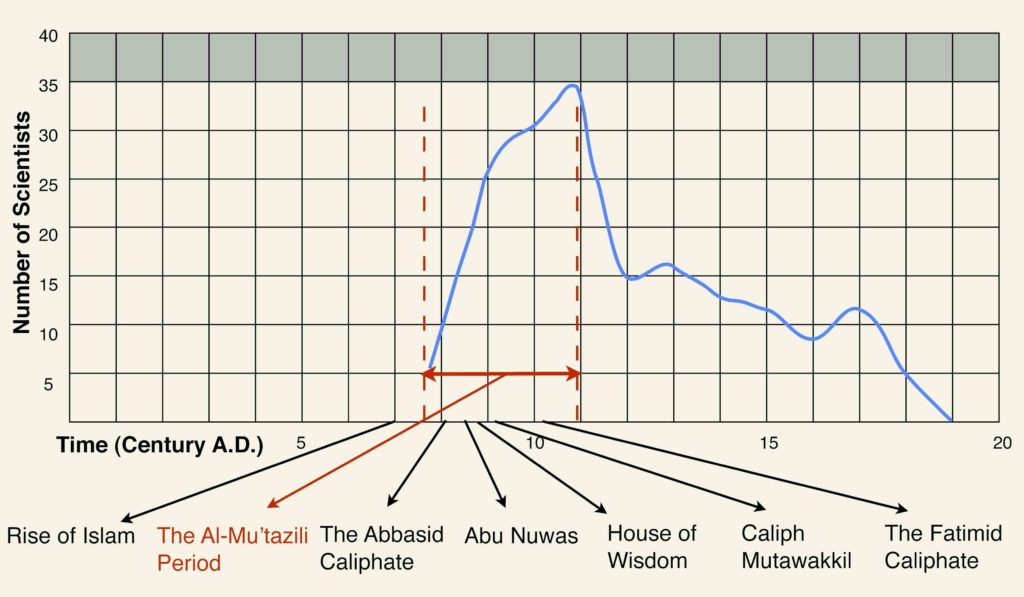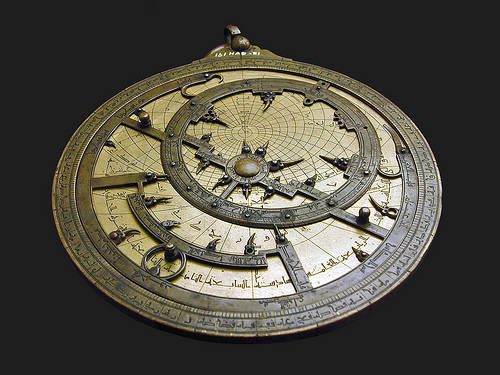
The spark of the first of the Arab civilisations recorded in world history is the nahda, the ‘resurgence’ which took place following the emergence of Islam. Islam, in this sense, is not merely a religion that appeared in the Arabian Peninsula but rather a cultural spur which promoted the combining of human and intellectual forces to construct the first civilisation of an Arab stamp. Thus, following the Caliphal state there emerged the Umayyad state, which was in turn followed by the ‘Abbāsid state, until finally the Arab pattern waned and in its place states of a religious stamp came to dominate the region.
READING BETWEEN the lines we may discern the phenomenon of a gradual, cultural growth, and thereafter the collapse of this nahda. In a separate study[1] I have dealt with Arab, Islamic scientific development. From a statistical survey of distinguished scholars over the centuries, it appears clear that scientific development in this culture grew over the first three centuries following the appearance of Islam, until this scientific development began to falter around the eleventh century AD in a period that was hostile to the Mu‘tazila[2]. The scientific lag has continued at this low level to the present day.
One ought to pause and consider closely the causes of the growth and decline evidenced in these three phases. There is no doubt that growth of science was connected to the rise of Mu‘tazilī thought. We find here that the rise and development of the Mu‘tazila school could not have occurred had there not been an intellectual space for freedom to allow for a rational debate concerning the Holy Writ. Similarly, it was the Mu‘tazila school which laid emphasis on the freedom of choice and on the responsibilities that accompany this (the beginnings, that is, of existentialist thought).
A freedom such as this is no easy matter. An indication of this is how the atmosphere of freedom is paired with a rise in song, music and profane poetry, and of the extremist thought of the Zindiqs [skeptics who applied a critical eye to revelation or tradition] and revolutions demanding freedom and justice, such as those of the Qarmatians[3] and the Zanj[4]. This free atmosphere prevailed in three Arab cultural hubs, the ‘Abbāsid, the Fātimid and the Andalusian, each of which contributed to the strengthening of intellectual talent. This period also witnessed a religious and ethnic tolerance on a very wide scale, one where Christians, Jews, Sabæans and Persians and indeed many faiths and ethnicities could contribute to this intellectual constructiveness. This period of history was the nearest thing to the secularism we are familiar with now, for it is in such an atmosphere that science flourishes and grows. The scientific and cultural achievements which this phase brought about are but an accurate indicator of the great broadening of freedom that obtained at the time.
Before Islam the Arabs had no heritage of philosophical thought, and this lone Mu‘tazilī speculative tradition was not supported by a solid historical background of Arab philosophy which could provide it with a firm support against faltering and break-up. Its infanticide was therefore a swift and easy matter, given that it appears to have ceased as a phenomenon after the eleventh century AD. This is in marked contrast to Greek thought which was able to accommodate eastern Christianity. When the religious mentality in Europe attempted to gain dominion over it and suppress intellectual freedom grounded upon broad philosophical thought, it was intellectual freedom that won out. Subsequently two distinct trajectories emerged that did not influence each other and could not cancel each other out.
Whenever knowledge finds a fertile environment, it settles for a longer period of growth
Rational Mu‘tazilī thought, however, was unable to continue in the face of intellectual suppression and fundamentalist persecution, and thinkers were unable to establish two separate trajectories each with its own properties, as happened in Europe. Statistical research (see chart) demonstrates the clear link between intellectual growth and stagnation parallel with the rise and fall of Mu‘tazilī thought. We can therefore say that it was the intellectual freedom which the Mu‘tazila provided that lay behind the orphaned scientific nahda, which collapsed when it did.
Many western and modernist Arab scholars have looked favourably at the Mu‘tazila and their cultural rôle. Among the Arabs is Ahmad Amin, who remarks in his book The Sacrifice of Islam:
to the present day Muslims would occupy a position in history different from their present state; they have been weakened by surrender and paralysed by fatalism, and complacency has settled in among them … in my view one of the greatest afflictions for the Muslims was the death of Mu‘tazilism.Had free thinking, that is, been left to develop along its natural course the situation would be entirely different from what it now is.
Intellectual decline is therefore one of the phenomena associated with the decline of intellectual freedom. Such a phase of freedom characterises the first nahda which Arab societies have known, only for them to subsequently live through a centuries-long slum
ber. In fact the seeds of most of the disasters and cultural setbacks, be they intellectual or political, that Arab and Islamic societies have endured go back to this general degeneration in the level of political freedom in societies and the domination of traditional modes of thought, modes where the present derives its sustenance from the past.
Hardline discourse suppressing the movement of thought has led to a cultural stagnation. The scientific phenomenon is a global phenomenon which most human societies have contributed to, transferring it from one society to another, growing like a snowball as it is transferred. A similar process in the game of scientific development took place in Arab Islamic culture. In the open society of the time translations of the achievements of the Indians, Greeks and other nations undertaken in institutions such as the Bayt al-Hikma contributed to translating the efforts of earlier men, and adding to them. As the Arabs took from others, so others took from the Arabs, and so on and so forth in the culture game.
The transference of knowledge is one of the drivers of development in science and human knowledge in general. Whenever this knowledge finds a fertile, suitable environment, it settles for a longer period of growth. This is what has taken place over human history and continues to occur. The West, for instance, was able to embrace earlier knowledge from different peoples in the world and provide it with a suitable environment for growth and freedom, which is the most important pre-condition for a scientific environment, in addition to some other factors related to material considerations.
This is how sciences flourished then and still grow now – by transferring human thought from one phase to another. If it were not for the bloody conflict which free thought has undergone in Europe from the period of the Middle Ages up to the time of the 18th-century Enlightenment, science and scientific thought could not have developed. And in step with the development of the natural sciences was the great social and human development that has taken place from the 16th-century until now.
The transference of knowledge from one place to another is the first phase in the scientific nahda, but is not the nahda itself. For the most important phase is the phase that lays down a suitable environment for growth, and it is this that the Arab and Islamic societies are unfortunately yet to grasp. It is the most difficult phase since it is one that requires the provision of a social, intellectual and material environment for growth.
The Islam that led to that scientific nahda is not the Islam of today, which is an Islam of accumulated obstructions heaped upon it by Muslim scholars during the centuries of darkness.
[1] http://philsci-archive.pitt.edu/9012/
[2] The rationalist Mu‘tazilī school is an Islamic school of speculative theology which flourished in the cities of Basra and Baghdad during the 8th–10th centuries. The adherents of the Mu‘tazilī school held that ‘the Speech of Allah Most High is created, invented, and brought into being’ in that, because of the perfect unity and eternal nature of God, the Qur’an must therefore have been created, as it could not be co-eternal with God. From this premise, the injunctions of God must be accessible to rational thought and inquiry: since knowledge is derived from reason, it is reason, rather than sacred precedent, that is the ‘final arbiter’ in distinguishing right from wrong. What is obligatory in religion is therefore only obligatory ‘by virtue of reason.’ This is opposed to the position of the textual literalists who held the extreme position that ‘the alphabetical characters, the materials on which they are written, the colours in which they are written, and all that is between the two covers [of the volumes of Qur’ān] is beginning-less and pre-existent.’ (Ed.)
[3] The Qarāmita were a Shi‘a Ismā‘īlī group centered in eastern Arabia, which attempted to establish a utopian republic in 899 AD. During the course of their revolt against the Abbasid Caliphate in 930 AD the Black Stone of the Ka‘ba was stolen and the well of Zamzam desecrated with Muslim corpses during the Hajj season. (Ed.)
[4] The series of rebellions of the Zanj (‘negroes’) took place in the 9th century AD, and reached their apogee at Basra where over a period of fifteen years (869-883 AD) it involved over 500,000 slaves and claimed over tens of thousands of lives in lower Iraq. The rebellions are also seen as a series of religious/social uprisings of the lowly-classed and suppressed citizens of the Basra area, in which the Zanj themselves were just one constituent among many. (Ed.)




